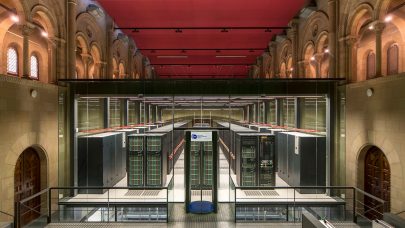
MareNostrum 5 Hits Speed Bumps; Iconic Chapel to Host Quantum Systems
May 23, 2023
MareNostrum 5, the next-generation supercomputer at the Barcelona Supercomputing Center (BSC) and one of EuroHPC’s flagship pre-exascale systems, has had a di Read more…

Europe to Dish out €270 Million to Build RISC-V Hardware and Software
December 16, 2022
The European Union will release €270 million in funds as it tries to attain technology independence by building chips based on the open RISC-V instruction set Read more…

RISC-V Is Far from Being an Alternative to x86 and Arm in HPC
November 18, 2022
One of the original RISC-V designers this week boldly predicted that the open architecture will surpass rival chip architectures in performance. "The prediction is two or three years we'll be surpassing your architectures and available performance with... Read more…

Nvidia, Intel to Power Atos-Built MareNostrum 5 Supercomputer
June 16, 2022
The long-troubled, hotly anticipated MareNostrum 5 supercomputer finally has a vendor: Atos, which will be supplying a system that includes both Nvidia and Inte Read more…

Intel Invests €33B in Europe, Announces ‘Silicon Junction’ Megasite
March 16, 2022
Intel has announced that it is making an “initial” €33 billion (~$36 billion) investment across the semiconductor value chain in Europe. The investment — which spans R&D, manufacturing and packaging — comes at a time when sovereignty is, more than ever, a headline priority for the continent. What was announced? A “Silicon Junction” in Germany with two new fabs... Read more…

Supercomputer Simulations Show How Paxlovid, Pfizer’s Covid Antiviral, Works
February 3, 2022
Just about a month ago, Pfizer scored its second huge win of the pandemic when the U.S. Food and Drug Administration issued another emergency use authorization Read more…

EuroHPC Restarts Procurement for MareNostrum5
December 21, 2021
Call it a New Year’s resolution: the EuroHPC Joint Undertaking—which serves as the concerted supercomputing play of the European Union—has issued a new ca Read more…

Amid a Canceled Tender, More Details of MareNostrum 5 (Finally) Emerge
June 28, 2021
Last October, the executive director of the EuroHPC JU – Anders Dam Jensen – said that with respect to MareNostrum 5 (the final pre-exascale EuroHPC system), “the tendering process was in its very final phase” and that “there would be announcements on that in the coming weeks.” Eight months later, the system’s status is still set to “it’s complicated.” Now, thanks to a brief presentation from... Read more…

- Click Here for More Headlines

Whitepaper
How Direct Liquid Cooling Improves Data Center Energy Efficiency
Data centers are experiencing increasing power consumption, space constraints and cooling demands due to the unprecedented computing power required by today’s chips and servers. HVAC cooling systems consume approximately 40% of a data center’s electricity. These systems traditionally use air conditioning, air handling and fans to cool the data center facility and IT equipment, ultimately resulting in high energy consumption and high carbon emissions. Data centers are moving to direct liquid cooled (DLC) systems to improve cooling efficiency thus lowering their PUE, operating expenses (OPEX) and carbon footprint.
This paper describes how CoolIT Systems (CoolIT) meets the need for improved energy efficiency in data centers and includes case studies that show how CoolIT’s DLC solutions improve energy efficiency, increase rack density, lower OPEX, and enable sustainability programs. CoolIT is the global market and innovation leader in scalable DLC solutions for the world’s most demanding computing environments. CoolIT’s end-to-end solutions meet the rising demand in cooling and the rising demand for energy efficiency.
Download Now
Sponsored by CoolIT
Whitepaper
Transforming Industrial and Automotive Manufacturing
Divergent Technologies developed a digital production system that can revolutionize automotive and industrial scale manufacturing. Divergent uses new manufacturing solutions and their Divergent Adaptive Production System (DAPS™) software to make vehicle manufacturing more efficient, less costly and decrease manufacturing waste by replacing existing design and production processes.
Divergent initially used on-premises workstations to run HPC simulations but faced challenges because their workstations could not achieve fast enough simulation times. Divergent also needed to free staff from managing the HPC system, CAE integration and IT update tasks.
Download Now
Sponsored by TotalCAE
Advanced Scale Career Development & Workforce Enhancement Center
Featured Advanced Scale Jobs:
HPCwire Resource Library
HPCwire Product Showcase
© 2024 HPCwire. All Rights Reserved. A Tabor Communications Publication
HPCwire is a registered trademark of Tabor Communications, Inc. Use of this site is governed by our Terms of Use and Privacy Policy.
Reproduction in whole or in part in any form or medium without express written permission of Tabor Communications, Inc. is prohibited.
























